The Folk Artistry of
Sac-a-lait Fisherman Glenn Davis
By Douglas Manger
In folklore studies the term "folk craft" refers to tangible objects that can be touched and felt. But the art of the folk in the greater Baton Rouge area, to bring the focus of this essay home, goes well beyond just tangible items. Indeed, in the vast beyond are to be found a wealth of deeply compelling folk genres, intangible in nature, that rely on those senses other than touch. Folk music and dance, customs and beliefs, oral traditions/verbal arts are among them. Not surprisingly in this varied landscape there are those traditions where the folk artistry is so subtle, or quite the reverse, so everyday, that they are overlooked even by folklorists well-schooled in the discovery process.
Consider the folk art genre of sac-a-lait fishing, a game fish pursuit taken to new heights of popularity by a large dedicated core of fishermen/anglers around Baton Rouge. The French name, "sac-au-lait", translates in English to "sack of milk", a reference to the sweet taste of the fish. Sac-a-lait is southern Louisiana usage. Elsewhere this species of fish is commonly referred to as a crappie (crop'-ee). A member of the sunfish family, be it a black or white crappie, the record weight is five pounds with well under three pounds the norm. Sac-a-lait are most often caught in the spring time when the annual spawn occurs, but certainly are fished year round.
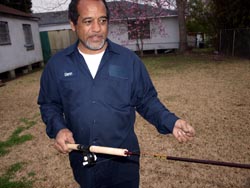
What we find when viewed through the lens of a folklorist is a particular sport-fishing tradition surprising in its multi-facets. Baton Rouge resident angler Glenn Davis is an exemplar of the tradition. What some astute observers would deem a folk artist hidden in plain sight, Davis remains ever active across critical genres (all of which he remains a student) to maintain his identity in the community as a master sac-a-lait angler. To comprehend this, imagine the folk art matrix as a series of rings—one within the other. The center ring is the exclusive domain of the folk artist(s). That's Glenn Davis in his boat on Lake Verret engaged in his craft. As the folk artist disengages from his craft, moving to the outer rings in this complex, they assume a more public persona. This is where Davis relates as a teacher, marketeer, mentor, storyteller, all in varying degrees, of course.
Glenn Davis was fortunate growing up. Although raised in Baton Rouge proper there were woods to explore nearby and a pond where he could try his hand at fishing. Davis enjoys telling the tale of his big catch as a kid.
One day as he approached the pond with his rod and reel in hand, he spotted a blue and black rubber worm on the ground. Setting his live bait aside Davis decided to give his new find a try. With the rubber worm firmly on the hook he let it fly out into the pond. Bam(!), immediately a fish struck the bait. The fight was on. When Davis finally landed the fish his eyes widened—a five pound bass! Walking straight home, his brothers called out, "Man, you just left here." "Yeah, and I just came back, too," Davis replied. "Look what I got!" His daddy was so proud he took the fish and had it mounted. That experience sealed the deal for Davis, he has never used live bait since.
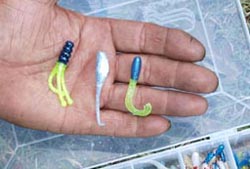
Davis's parents and grandparents before them were all avid fishermen. His daddy, nicknamed "Fly Rod", enjoyed taking his sons out fishing on his boat. He loved being on the water in beautiful surroundings. Eventually Davis's brothers left fishing behind to take up hunting. Not Davis. He stayed with fishing right where his passion lay. "I enjoyed it more. [There is] more peace of mind to fish." Now at least two days a week—mostly on Fridays and Saturdays—Davis shuts his automotive shop down and heads for his favorite fishing spots; Lake Verret, Old River, or the Atchafalaya Basin, where the quality pound-and-a-half-to-two-pound sac-a-lait are to be found.
Nuances
The desire to experience the thump will drive a man to leave work on a good day.
-Deon Turner
According to Davis there are two types of sac-a-lait fishermen, those who prefer "shiner" or live bait, and those who prefer to use a "jig" or artificial lure. Davis calls those who use shiners "tree top" fishermen. "They let the live bait do all the work," he insisted.
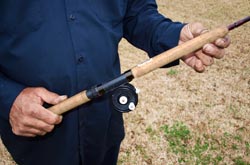
Davis's knowledge of the nuances of sac-a-lait fishing is legendary among Baton Rouge anglers. Boat in the water trolling from tree-to-tree Davis looks for structures where the sac-a-lait, a schooling fish, might congregate. Determining at what depth the sac-a-lait will bite is critical. An inch might make all the difference. "Water depth," Davis explained, "determines how deep you are going to fish and where the fish are to be found." The depth may vary depending on the season. In the summer sac-a-lait tend to run in deeper water where water temperatures are in the 65-68 degree range.
When he finds a promising spot Davis will begin to "tightline:"
Tightling is fishing without a cork. You just letting the string [line] hang, no slack, and you just bumping the jig pole up and down. And when that fish hits you can feel him. With a cork, you don't really feel the fish. You're watching for the cork to sink, and that's when you know you have the fish. But tightling you don't give them any slack and you can feel them in the pole through your hand when they hit it. And, so to me, it's a better way of fishing because, like I say, you don't have the slack to give the fish time enough to run with it, you know. I just enjoy that more than I do fishing under a cork. (Davis, 2014)
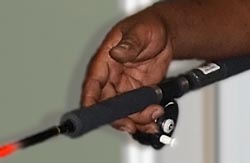
Tightlining requires subtle movements of the pole using lots of wrist action. "Love it," Glenn exclaimed, "I just love to feel that bump when they hit it. So that's (tightlining) 80% of my fishing." In angler's jargon, jerking a jig or another type of bait up and down in the water is called "jigging". The art of sac-a-lait fishing at its core is knowing when to jig and with how much wrist action, a deceptively simple challenge to be sure. Judging from his reputation, few Baton Rouge based anglers do it better and with more success than Glenn Davis.
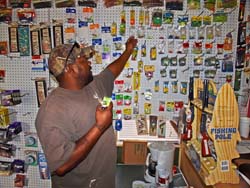
Some old-timers say a jig pole is nothing more than a high-tech cane pole with lots of built-in flexibility. Manufacturers today use cutting edge high-tech graphite materials to provide both the strength and sensitivity demanded by sac-a-lait fishermen.
A jig pole is longer than a traditional fly rod with more eyes. The reel on a jig pole is also smaller than those used by fly fishermen. For tightlining Davis uses a 10 foot pole. On those fewer occasions when he uses a cork he switches to an 11 foot pole. Once again, when a sac-a-lait strikes the jig the angler feels the hit directly through the pole. That's why a sensitive pole is a must to enable the angler to feel the fish when it does so. In contrast, given the slack in the line when a cork is used, the angler won't necessarily feel the fish take the bait.
Friend, student of the tradition, and fellow sac-a-lait fisherman, Deon Turner, owner of Boss Man's Bait and Lures in Baton Rouge, refers to the "unspoken language among men [engaged in the tradition] about the thrill of the 'thump,'" that moment when the sac-a-lait takes the bait. It's a sensation that has brought many new anglers over to sac-a-lait fishing in recent years. With a broad smile Turner shared a bit of local lore: "The desire to experience the thump will drive a man to leave work on a good day." Turner added: "A jig pole is a art. It's a part of Cajun heritage . . . the Cajun way of living, the way we get up in those trees and around those stumps. . . . The jig pole is for precise getting it in there up in the tree and letting your lure fall down between the branches which is impossible with a rod and reel." From its cane pole roots to today's high tech jig poles, sac-a-lait fishing gear over time has been adapted to work in tight spaces leaving the conventional rod and reel for more open environments.
Presentation
I understand everybody got a honey hole
(a favorite fishing spot).-Deon Turner
Critical to sac-a-lait fishing is "presentation", a collective term that refers to a combination of choices a fisherman makes: the choice of lure, color, and size; the type of pole and/or tackle used; the structure targeted; the casting technique; the retrieval technique (slow, medium, fast, stop-and-go); and where the bait is worked in the water column (deep, shallow, top-water).
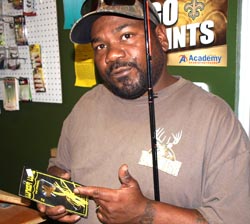
With Davis the coloration of the water is a major factor. On one fishing outing he came upon a structure alive with minnows. If sac-a-lait were feeding on the minnows, Davis reckoned, a jig in the gray scale might just do the trick. Twenty eight sac-a-lait later he was bound for home. Of course, short of referencing a handy field guide like The Applied Folk Methods of Sac-a-Lait Jig Fishing, if it even existed, compels the fisherman to logic his approach from past experience, and from what he's observing around him. "I always look at the water, water color, water clarity to determine what [jig] I'm going to use," Davis explained. "Find different structure. . . . Find out what they want. . . . It's different every day. If you fish it enough, you'll learn it, and you'll find out how to fish it." All factors are swept aside; however, when the sac-a-lait spawn in the spring. During the spawn the sac-a-lait bite on almost anything.
Reading the Landscape
You're favorite bait is like your child, especially in the South. . . . To me, let me try my jig pole. I'm going to keep faith in Old Faithful. You know I was raised, if it ain't broke, why fix it?
-Deon Turner
Through his years of sac-a-lait fishing Davis has developed a keen eye for reading different terrain. On Lake Verret due south of Baton Rouge, one of Davis's favorite fishing spots, many fishermen new to the lake quickly become disoriented in the maze of canals and inlets. Not Davis, however, for good reason. From dawn to dusk, if he is not fishing, Davis "rides" the lake on the lookout for shoreline markers and structures in the water. The term "structure" refers to changes in the shape of the bottom of lakes, rivers, or impoundments, especially those that influence fish behavior. Examples include flooded roadbeds, humps, ledges and drop-offs, fallen trees and stumps.
To determine just when the fish will feed some anglers turn to the Old Farmer's Almanac for help. As one might expect myths and legends abound about precisely when, where, and how to approach sac-a-lait:
Fish don't bite on a full moon.
Snakes in a tree, there must be fish below in the water.
Blue Heron hesitant to leave, there must be fish about.
In murky water the bait must have a reflecting eye on it because fish like sac-a- lait look for the reflecting eyes of a predator.
As for Davis, he will have none of it. "It's how you're presenting the jig to them," he declared, "and finding out what they want, what they're feeding on."
Mentoring
He wise with it; he got the plaques to show it; and people in the community speak highly of him.
-Deon Turner
"Got to take my hat off to men like that who just keep it alive; [otherwise] it'll die off," Turner exclaimed. Both Davis and Turner realize the importance of keeping the sac-a-lait fishing tradition alive for future generations. Turner spoke to the wisdom of "older guys" and their wealth of knowledge about the tradition. "I meet guys like Davis and I hear stories about him and I was fascinated to meet him."
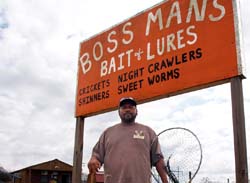
Raised in the country Turner was no stranger to a cane pole with live bait on the hook. With a love of casting he later began using a rod and reel. Now with jig pole in hand Turner is being mentored by Davis. Straight to the point Davis fired back when Turner voiced a concern: "You're jigging too much. Let the bait be a natural bait in the water. Just let it float down and be in the strike zone." Observing master sac-a-lait fishermen like Glenn Davis and others in action has given Turner a leg up. Now "four years into it" Turner, too, is also becoming wise with it: "Muddy water want a dark bait. Clear water want a loud bait. Black sac-a-lait like pylons and structures (where males prepare the beds for females to spawn.) Big white sac-a-lait like the tree tops."
Turner explained why he's drawn to Davis and why he's anxious for Davis to be known by more people in the community: "I want people to be able to feel this passion that he feel; he wise with it, he got the plaques to show it, and people in the community speak highly of him."
When Davis is fishing for sac-a-lait it's not uncommon for him to be on the water from the first light of dawn to sunset. To be sure his unbridled passion for the sport has brought many converts to the fold.
Once you go with somebody, that's when they get attracted to it. Now I'll get guys that never fished go with me and they'll watch me fish. You know, some of them will sit back and laugh. "Man, you take this serious." I say, "Yeah, I take it like a job." I say, "I go to my job to make money, I come out here to catch fish. I don't spend all this money just to . . . . But they'll sit back and laugh, but then they get hooked on it. And then they say, "Ok, well, when can we go again?" And they ready to go again. So you like, "Ok, well, hey, I go every weekend, you know, you're more than welcome to come. Just, you know, bring you something to eat because I'm going to be all day." I let them know that. I say, "I'm going to leave at dark and I may come home at dark." I say, "That's how much I love it." I say, "I'm going to stay out there all day." I say, "It's peace of mind. I don't have nothing to bother me out there. I don't think about nothing but fishing. That's it." You know, and it's just one of those things, once you go you will get hooked on it. (Davis, 2014)
Ever aware of the importance of passing it down to the next generation Davis is now bringing his son into the tradition with regular weekend outings at his favorite fishing spots.
Gathering
I'm going to talk noise and I'm going to brag.
-Glenn Davis
It's the size and quality of the sac-a-lait that Davis is after, not the numbers; and of course, the bragging rights hard earned for bringing in a prime catch. After a successful sac-a-lait outing, Davis declared, "I'm going to talk noise and I'm going to brag." Many evenings after work he takes the opportunity to do just that.
Just shy of closing time, late customers, friends, acquaintances, passers-by, even the duty patrol cop, begin to gather at Davis Auto Shop in northeast Baton Rouge. As the crowd begins to mesh the informal meet and greet becomes an ever more lively kinship gathering of sorts—mostly African American males of various ages "talking a lot of mess." To be certain, Davis is the draw. Those on hand seem to just plain relish the time hanging out with him. Although in no way contrived the meet-up works on another level, as well: to bolster Davis's reputation as both a respected business owner and master of his sport. As the noise level mounts Davis moves easily from one conversation to the next. Shop talk, boat talk, the latest sac-a-lait outing, or the big tournament around the corner, Davis is often at center stage. A master raconteur Davis, too, is always ready with a tale:
It's dangerous out there. You've just got to be responsible. You got to know what you're doing. Last year I had an alligator get in my boat. In the boat! I was up against these lilies, fishing down through these lilies. And I can see where a lily was smashed down looked like an alligator was bedded there. Well, my boat couldn't go nowhere because the way the water was drifting it had me up against the lilies. So I'm sitting there, OK, well, I'm catching fish. So I caught a sac-a-lait and when I swung him to the boat he fell off in the boat on the back deck. So I decided, say let me go get him before he gets in the water. Well the alligator was sitting back there, probably about a six foot alligator. I didn't see him, but he must have just had his nose [up]. When he seen that fish that's actually what he was going for. He come out of the water—I mean like a rocket—and he hit the back deck of that boat, and by that time, I'm, I'm heading back there. Why, I done turned around and ran to the front. Say this man, this old man and his wife fishing. And I'll never forget that. Boy, they were dazed. They was like, they couldn't say anything. And I'm sitting on the front of the boat and I'm thinking, "OK now, one of us is going to leave this boat. Either me or him." But he was just as scared as I was so when he seen me he finally left the fish. He didn't touch the fish. He just went off the side of the boat. And that guy looked at me and said, "Man, did I see what I thought I just seen?" I say, "I hope you seen it, because I know I seen it." I say, "Nobody's going to believe that." (Davis, 2014)
It's here at the gathering where we see Glenn Davis the folk artist operating in those outer rings, outside the core in the more public domains. It's here where we begin to appreciate that Glenn Davis' folk art mastery also extends to the art of making the sale, of telling the tale, of sharing the knowledge, of making new converts. Out on the side street neighborhood passersby give Davis the horn or a shout-out. With the same action he's honed on his jig pole, Davis acknowledges each one with a flick of his wrist and a five finger hello, never missing a beat in conversation.
Conclusion
Patience . . . Days are going to be better than others. . . .
You have to have the patience to stay out there and stick
with it to make it worth your while going.-Early advice from Glenn Davis' Daddy
As with all folk art, a filtering of possibilities leads to one singular approach. In Davis's case that means recall based on years of experience. In other cases one would suspect, there's no reflection at all, just a gut reckoning "I think this will work" sort of approach. Nuancing the approach is feasible of course within certain parameters. Jigging at different depths, use of more or less wrist action, switching jigs, are all possibilities. And if all else fails trolling to another location.
The folk artist works within a matrix. When imagined as a series of rings one within the other, it is the center ring where we observe the artist at work. As the folk artist moves away from his work into the outlying rings, if you will, they take on a more public persona. In Davis's case when this occurs we see other facets of the tradition played out by a man who continues to strive to master them all: the artist/promoter, avowing the merits of the tradition at gatherings while recruiting contestants for his next sac-a-lait tournament; the artist/mentor, teaching the craft to others; the artist/raconteur, sharing personal tales about his experiences in the tradition. In all these performance roles, like all artists, he remains ever a student absorbing new information on technique, presentation, and the ever changing landscape.
"I'll go behind anybody and catch fish. That's how much confidence I have in myself," Davis declared. It's good to hear the declaration. It will take that air of confidence for Glenn Davis to continue to match his past successes in pursuing southern Louisiana's sac-a-lait, in season an oft elusive catch equal to the challenge.
Sources
Davis, Glenn, and Deon Turner. 2014. Interview by Douglas Manger, February 23.



